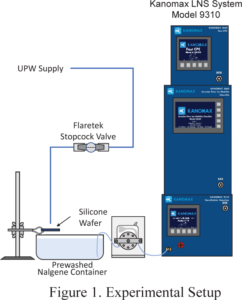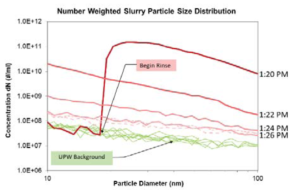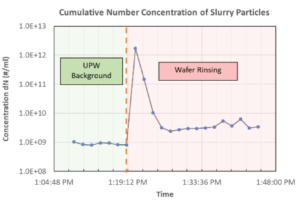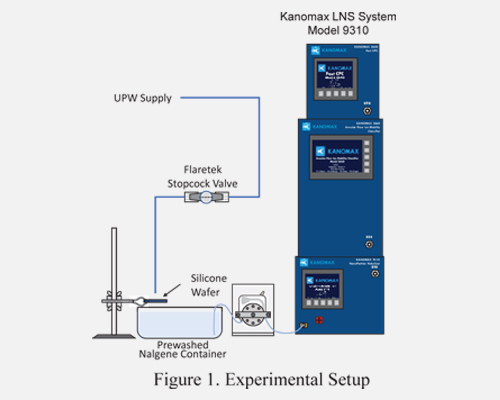Post CMP Clean Effluent Endpointing and Monitoring with the LNS System
Siqin He, Derek Oberreit, and Steve Kosier
Kanomax FMT, Inc., 4104 Hoffman Rd., White Bear Lake, MN 55110, USA.
*Corresponding e-mail: Siqin.He@KanomaxFMT.com
Keywords: CMP; post cleaning; particle characterization
ABSTRACT – CMP is extensively used in silica-based semiconductor manufacturing, and the post CMP cleaningis therefore a critical process after the wafers being polished by CMP slurries [1]. Often with the UPW rinse as the last step, particles in the effluent from the UPW rinse can becharacterized for their size and corresponding concentrationas an essential parameter to evaluate the effectiveness and outcome of the overall cleaning process. This paper presents an application of using the Liquid Nanoparticle Sizer (LNS) system as an inline monitor to measure the sizedistribution of particles in the rinse effluent.
1. BACKGROUND
Post CMP (pCMP) cleaning is one of the most important steps in the CMP process flow. A typical process flow will involve multiple polish steps, followed by several pCMP clean steps involving megasonic tanks, brush stations, and different chemical treatments. The last step in the pCMP sequence is typically an Ultrapure Water (UPW) rinse followed by a Marangoni dry step.
The final UPW step is intended to remove any last particles from the wafer before sending the wafer to the drying step. The effluent from UPW the rinse may be monitored for particles to determine the cleanliness of the wafer and check for any excursions or unexpected behavior. In despite of the increasing demand of accuracy and sensitivity in monitoring the cleaning performance, to take out this measurement of sizing low concentration nanoparticles in UPW has been a challenge due to the limitation in currently available optical particle counting technologies [2, 3], far less to apply it as an evaluation parameter.
2. SYSTEM INTRODUCTION
The Liquid Nanoparticle Sizer (LNS) System can be used to fill this gap [4]. The LNS measures particles at above 80% counting efficiency across the 6 – 360 nm size range with a sizing resolution of 64 channels per decade, and it provides actual (not relative) number concentration for each corresponding particle size independent of particle shape or composition, and scans through the entire size range in less than 5 minutes. In addition to the scan mode which measures concentration and size spectra of the entire size range, the LNS can also be used in a single size mode that monitors the concentration change of a certain size as fast as one count per second. This fast response capability allows for the rinse process to be continuously monitored and end-pointed to ensure that only clean wafers are passed on to the drying step.
3. EXPERIMENT AND RESULTS

The experiment was setup in a way to mimic the UPW rinse situation, as shown in Figure 1. A silicon wafer was deposited with 500 μL CMP slurry, such as might be left behind in the pCMP clean process, a UPW flow is introduced at a constant flowrate towards the deposited surface as the rinse liquid, and the effluent is collected in a prewashed Nalgene container which is continuously sampled by the LNS System.
Experimental results are plotted in Figure 2. The size distribution of particles in the effluent was continuously measured from before and throughout the rinse process with results plotted in a sequence of time points, as shown in Figure 2(a). Each line represents the concentration spectrum measured from one LNS scan, with the ending time of that scan marked to the right. Lines are color coded to reflect the total concentration level, with red showing the post CMP cleaning process and green representing the prior. Figure 2(b) plots the total concentration of particles in the effluent cumulated over all sizes measured as a function of time. A dashed line is drawn at the time point when the UPW rinse process was initiated. The concentration started from a low number concentration which was measured as the UPW reference background and spiked at the time when a CMP slurry deposited wafer was moved to the UPW flush line. As time progresses the wafer gets cleaner and the concentration of particles in the effluent water gets lower. Eventually the effluent water cleans up and returns to baseline cleanliness, which is the endpoint of the UPW rinse process.


(a) Number weighted slurry particle size distribution
(b) Cumulative number concentration Figure
2. Experimental Results
4. SUMMARY
Performance of the post CMP cleaning is extraordinarily critical to the yield in silica-based semiconductor manufacturing, which also highlights the necessity and importance to have a reliable examination tool to evaluate the effectiveness of the cleaning process. With particles being one of the major sources of contamination and defects [5], particle monitoring of the final UPW rinse effluent is ideal for probing the cleaning result. The LNS system, with its specialty in fast-response measurements of particle size distributions in liquid, can therefore have great benefit for line monitoring, protecting downstream equipment, and preventing yield excursions.
REFERENCES
Journal articles
- Tseng, W.-T., Wu, C., McCormack, T., & Yang, J.C. (2017). Post Cleaning for FEOL CMP with Silica and Ceria Slurries. ECS Journal of Solid State Science and Technology, 6 (10) 718-722.
- Jeon, S., Oberreit, D.R., Van Schooneveld, G., & Hogan Jr., C.J. (2016). Nanomaterial size distribution analysis via liquid nebulization coupled with ion mobility spectrometry (LN-IMS). Analyst, 141.4: 1363- 1375.
- Donnelly, M.K. and Mulholland, G.W. (2003). “Particle size Measurement for Spheres with Diameters of 50 to 400 nm”, National Institute of Standards and Technology, Report # NISTIR 6935.
Conference papers
- Blackford D.B. and Grant, D.C. (2009). A proposal for measuring 20-nm particles in high-purity water using a new technology. Ultrapure Water, January 2009.
- Kim, H.J. (2018). Defects and Post CMP Cleaning. International Conference on Planarization/CMP Technology, CMP Tutorial, October 2018.


